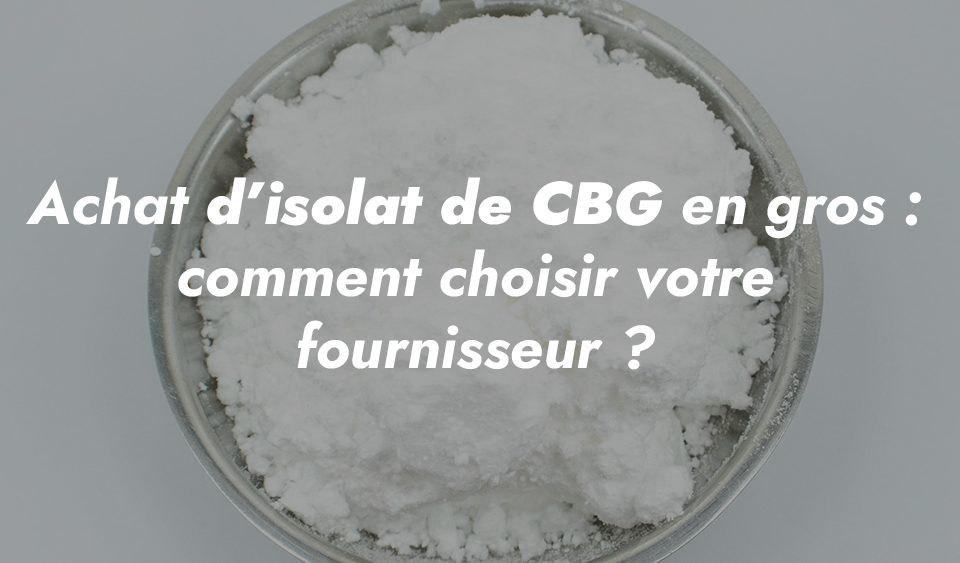
What is CBD? Zoom in on a cannabinoid like no other
December 10, 2020
CBN: what is cannabinol?
January 15, 2021When we say "cannabinoid", we mean THC. Many of you will also think of CBD, whose therapeutic use is becoming increasingly well known, especially since cannabis has (finally) been removed from the list of hard drugs.
In any case, when someone says "CBG", few hands are raised. Yet this cannabinoid is fast becoming an industry staple .
THC, CBD... and CBG: what is this third cannabinoid?
Cannabigerol, discreet among its own kind
No, it's not a typo. We're talking about CBG here. And if very few people know what it is, it's simply because this cannabinoid is present in very small quantities.
Most mature cannabis plants contain less than 1% CBG.
It's not much, but it's enough to make it the third most important phytocannabinoid of its kind. Let's not forget that the cannabinoid family is vast. In fact, there are over 120 of these chemical substances!
CBG at the root of THC and CBD genesis
Given its low concentration, one might think that CBG 's role is anecdotal. But quite the opposite is true. So, what is CBG?
Well, CBG is no more and no less than the precursor to THC and CBD. In other words, without CBG, there's no CBD or THC.
As you know, THC and CBD are synthesized during the plant's flowering period. And this is precisely when CBG levels are at their highest. This enables the synthesis of our cannabinoid duo.
To be a little more precise, it's actually CBGA, the acid form of CBG, which is responsible for the synthesis of THCA and CBDA (the acid forms) as cannabis flowers develop.
During the transformation process, these molecules are subjected to temperatures of varying degrees . This triggers the phenomenon known as "decarboxylation", during which these molecules lose their acid attribute.
This leads to the formation of THC and CBD as we know them.
How cannabigerol (CBG) works: how does it behave once in the body?
Cannabigerol, like all phytocannabinoids, interacts with our endocannabinoid system (ECS), which contains the famous CB1 and CB2 receptors.
For those unfamiliar with this jargon, let's just say that the SEC is a kind of specialized processing platform for cannabinoids. The reason we have them is that our bodies naturally and autonomously produce cannabinoids. Hence the term endocannabinoid system.
Some of these substances have more affinity with one or other of the two receptors, and each will have a very specific impact on the body. For example, THC stimulates CB1, resulting in euphoric effects.
As for CBG, it appears to be a powerful alpha-2 adrenoceptor agonist, making it a CB1 inhibitor and, conversely, a CB2 stimulator. It also has certain affinities with the well-known hormone serotonin.
What do we know about the effects of CBG?
Similarities between CBG and CBD
As we said earlier, CBG is a CB2 agonist. Like CBD, CBG offers numerous therapeutic advantages:

CB2 agonists help protect and heal the intestines. They also help keep our neurons healthy, preventing the onset of neurodegenerative diseases.

with recognized pain-relieving powers. In fact, hemp has been used for this purpose since ancient times.
Research into the therapeutic potential of cannabinoids in cancer treatment is extensive and conclusive. In particular, CB2 agonists such as CBG have been shown to induce tumor regression .
The benefits of CBG for the nervous system
In addition to its interaction with CB2, CBG is a moderate antagonist of the 5HT1A receptor. This aspect of the cannabinoid has been the subject of very few studies, but if we look at the role of 5HT1A receptors, we quickly realize that CBG opens up a whole new field of possibilities.
In fact, this receptor is closely linked to the secretion of serotonin, a hormone known for its beneficial effects on mood, anxiety, stress and depression.
This other study also highlights CBG's other beneficial effects on the nervous system. This time, its inhibitory properties on GABA were studied. Since GABA is the main inhibitory neurotransmitter in the central nervous system, CBG is said to induce muscle relaxation and anti-anxiety effects.
Potential therapeutic applications of CBG
In addition to its interaction with CB2, CBG is a moderate antagonist of the 5HT1A receptor. This aspect of the cannabinoid has been the subject of very few studies, but if we look at the role of 5HT1A receptors, we quickly realize that CBG opens up a whole new field of possibilities.
In fact, this receptor is closely linked to the secretion of serotonin, a hormone known for its beneficial effects on mood, anxiety, stress and depression.
This other study also highlights CBG's other beneficial effects on the nervous system. This time, its inhibitory properties on GABA were studied. Since GABA is the main inhibitory neurotransmitter in the central nervous system, CBG is said to induce muscle relaxation and anti-anxiety effects.





